物理专业英语课件
动力工程及工程热物理专业英语课件

Engineering thermophysists contribute to the development of advanced energy conversion technologies like thermal power plants and heat engines, as well as energy storage systems such as thermal energy storage
Combustion and Pollution Control
• Combustion Fundamentals: The courseware should cover the fundamentals of combustion, including chemical reactions, flame stability, and combustion efficiency Students should learn about different types of communicators and how to design them for optimal performance
02
Professional Fundamentals
Fundamentals of Thermodynamics
01
Laws of Thermodynamics: The courseware should cover the three laws of thermodynamics, which are the foundation of power engineering and engineering thermophysics These laws explain the relationship between heat and work, and they govern the behavior of energy in all systems
物理学专业英语讲义
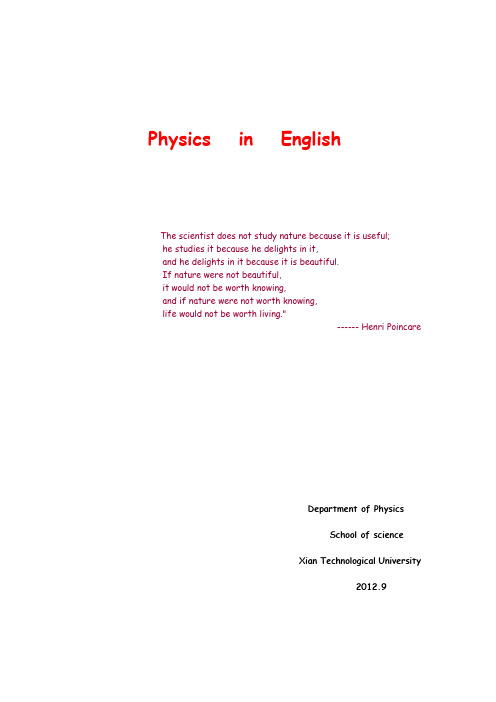
Physics in EnglishThe scientist does not study nature because it is useful;he studies it because he delights in it,and he delights in it because it is beautiful.If nature were not beautiful,it would not be worth knowing,and if nature were not worth knowing,life would not be worth living."------ Henri PoincareDepartment of PhysicsSchool of scienceXian Technological University 2012.9Chapter 1 What is Physics?Physics is natural science studying nature's LawsPhysics was called natural philosophy and fundamental science.The history of physicsThe history of physics encompasses two broad time periods in which classical physics and modern physics developed. Classical physics developed between 1600 and 1900. It embraces the general areas of physics known as mechanics, thermodynamics, and electromagnetism, culminating in relativity. Modern physics began developing between about 1890 and 1930, when it was realized that classical physics could not account for the newly discovered behavior of nature at the atomic and molecular level. Modern physics includes the theory of relativity as well as quantum mechanics and most of the subsequent new physics discovered and developed during the 20th century.Classical physicsClassical physics includes the traditional branches and topics that were recognized and well-developed before the beginning of the 20th century—classical mechanics, optics, thermodynamics, and electromagnetism. Classical mechanics is concerned with bodies acted on by forces and bodies in motion and may be divided into statics (study of the forces on a body or bodies at rest), kinematics (study of motion without regard to its causes), and dynamics (study of motion and the forces that affect it); Acoustics, the study of sound, is often considered a branch of mechanics because sound is due to the motions of the particles of air or other medium through which sound waves can travel and thus can be explained in terms of the laws of mechanics. Among the important modern branches of acoustics is ultrasonics, the study of sound waves of very high frequency beyond the range of human hearing. Optics, the study of light, is concerned not only with visible light but also with infrared and ultraviolet radiation, which exhibit all of the phenomena of visible light except visibility, e.g., reflection, refraction, interference, diffraction, dispersion, and polarization of light. Heat is a form of energy, the internal energy possessed by the particles of which a substance is composed; thermodynamics deals with the relationships between heat and other forms of energy. Electricity and magnetism have been studied as a single branch of physics since the intimate connection between them was discovered in the early 19th century; an electric current gives rise to a magnetic field and a changing magnetic field induces an electric current. Electrostatics deals with electric charges at rest, electrodynamics with moving charges, and magnetostatics with magnetic poles at restThe Emergence of Classical PhysicsClassical mechanics has its roots in the work of Johannes Kepler, who, between 1600 and 1619, became the first person to describe quantitatively and accurately the elliptic paths of the planets around the Sun.The problem of the shape of the planetary orbits was not easy to solve, because all historical observations of the planets were made from the Earth, itself a moving planet. Although a crude heliocentric(Sun-centered) model of the solar system using circular orbits was proposed by the Greek astronomer Aristarchus in the third century B.C. and resurrected by Copernicus in 1542,the planetary positions predicted by Copernicus were not as accurate as those found using Ptolemy's complicated geocentric (Earth-centered} model of the second century A.D.The pure Copernican model was inaccurate because Copernicus refused to abandon the flawed concept of early Greek thought that the natural path of a moving "perfect" celestial object, such as a planet, had to be in the shape of the "perfect" geometrical figure---a circle---with the planet moving at constant speed. a scientist living at the time of Copernicus would have been forced to reject the Copernican theory with its circular planetary orbits, since they did not account for the observed motions of the planets as accurately as the existing, but more complicated, geocentric theory of Ptolemy.The change from the accurate but complex Ptolemaic geocentric model of the solar system to the accurate and simple heliocentric model of Kepler illustrates the characteristics of a good theory. With Kepler's work, accuracy and simplicity blossomed simultaneously from the heliocentric hypothesis. Kepler's model and mathematical methods began the development of physics as we know it. His work was a watershed of quantitative thought and a new worldview.Observation of nature and experimental results typically precede the general theories that account for them. The extensive observations of the planets by Tycho Brahe just prior to 1600 provided Kepler with the data he needed to model the solar system accurately and precisely。
物理学专业英语A6

A6 Waves and rays
• Our eyes experience different wavelengths as different colours. These range from red (0.000 7 mm) down to violet (0.000 4 mm). As light waves are so short, they are not noticeably diffracted by everyday objects.
A6 Waves and rays
• Diffraction Waves bend round the edges of a narrow gap. This is called diffraction. It is significant if the gap size is about a wavelength. Wider gaps cause less diffraction. • Interference If two identical sets of waves overlap, they may either reinforce or cancel each other, depending on whether they are in phase ('in step') or out of phase.
A6 Waves and rays
NEW WORDS Page.16 NEW WORDS Page.17
A6 Waves and rays
• Types of wave motion • Waves transfer energy from one place to another. Where ever there is wave motion, there must be: • a source of oscillation, • a material or field which can transmit oscillation. • Wave motion can be demonstrated using a 'slinky' spring, as shown below. The moving waves are called progressive waves. There are two mais
物理学专业英语(2)2009

7 six-inch timbers , two 7-man crews,
fifteen 25-watt lamps
4. Estimateຫໍສະໝຸດ numerals spelled in English
The company has enough timber to operate for forty years.
(四)“more” 1. more than 1000,000 people 2. in excess of 2,000 square miles 4. upward of 800 water pumps 5. the hat cost over $5 6. 2 miles and more 7. 2 miles or more (五) “less” 1. below 876 2. less than 3,000 3. under 22 ms
Increased or decreased by… 1. A is by 2 longer than B. A=B+2 2. The prime cost decreased by 60%. A=(1-60%)B 3. The strength of the current is stepped down by sixth. double= 2 times(twice) , triple= 3 times , quadruple =4 times A=(1-1/6)B=5/6B
the exists re for all
p q p impliesq / if p, thenq p q p if and onlyif q /p is equivalent to q
ab a :b 90
大学物理学专业英语2
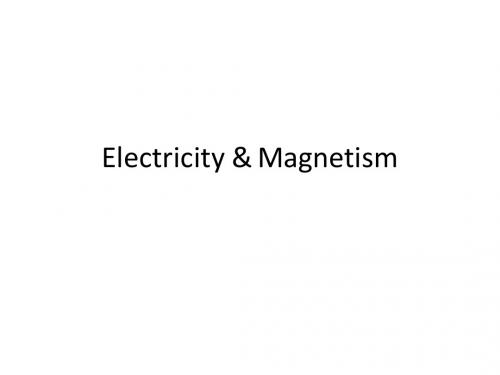
Electric charges and fields
Electric force:
F
Q1 (+)
Q2 (+)
F
r Charges attract or repel each other with an electric force. If point charges Q1 and Q2 are distance r apart, and F is the force on each, then according to Coulomb’s law: Q1Q2 F 2 r This is an example of an inverse square law. If r doubles, then force F drops to one quarter, and so on. With a suitable constant, the above proportion can be turned into an equation: kQ1Q2 The unit of charge for Q1 and Q2 is the coulomb (C). F r2
The capacitance C of a capacitor is defined as follows:
E r
Electric potential
Q Electric potential V q P Work done W
∞
Charge Q causes an electric field. A small charge q has been moved through this field, from an infinite distance (where the electric force is zero), to point P. The electric potential V (at point P) is defined as follows:
物理学专业英语仲海洋版9.2节
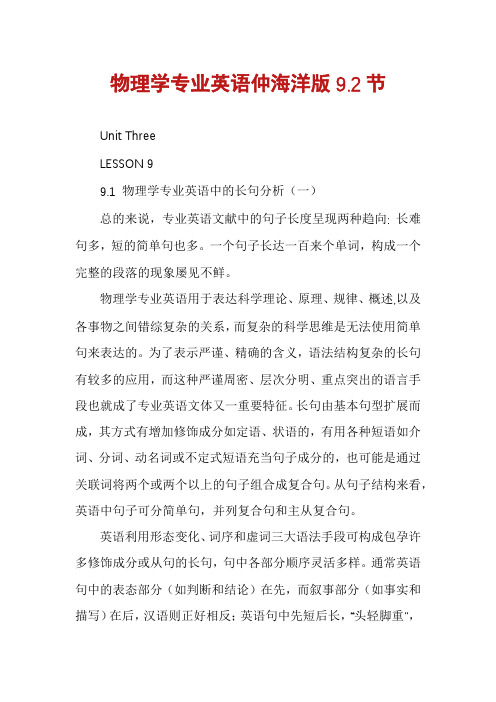
物理学专业英语仲海洋版9.2节Unit ThreeLESSON 99.1 物理学专业英语中的长句分析(一)总的来说,专业英语文献中的句子长度呈现两种趋向: 长难句多,短的简单句也多。
一个句子长达一百来个单词,构成一个完整的段落的现象屡见不鲜。
物理学专业英语用于表达科学理论、原理、规律、概述,以及各事物之间错综复杂的关系,而复杂的科学思维是无法使用简单句来表达的。
为了表示严谨、精确的含义,语法结构复杂的长句有较多的应用,而这种严谨周密、层次分明、重点突出的语言手段也就成了专业英语文体又一重要特征。
长句由基本句型扩展而成,其方式有增加修饰成分如定语、状语的,有用各种短语如介词、分词、动名词或不定式短语充当句子成分的,也可能是通过关联词将两个或两个以上的句子组合成复合句。
从句子结构来看,英语中句子可分简单句,并列复合句和主从复合句。
英语利用形态变化、词序和虚词三大语法手段可构成包孕许多修饰成分或从句的长句,句中各部分顺序灵活多样。
通常英语句中的表态部分(如判断和结论)在先,而叙事部分(如事实和描写)在后,汉语则正好相反;英语句中先短后长,“头轻脚重”,而汉语也正好相反;英语借助形态变化和连接手段而将句中成分灵活排列,汉语则常按时间和逻辑顺序由先到后、由因到果、由假设到推论、由事实到结论这样排列。
在专业英语的学习中,长句的分析是一个非常重要的基础,无论是专业文献阅读、翻译还是严谨精确地写作,都要从长句分析开始。
长句分析既重要也有些难度。
然而,无论多长的句子、多么复杂的结构,它们都是由一些基本的成分组成的。
只要弄清英语原文的句法结构,找出整个句子的中心内容,理解各层意思,然后分析各层意思之间的逻辑关系,再按汉语的特点和方式表达就可以理解或译出原文了。
9.1.1 长句结构的分析抓住主干,添枝加叶。
所谓抓住主干,就是在理解长句时首先要找到主语、谓语这两个主要成分。
添枝加叶,就是在主语、谓语这两个主要成分的基础上,逐个加上各种修饰语,包括定语、状语、补语、非谓语动词结构、各种从句等。
物理学专业英语
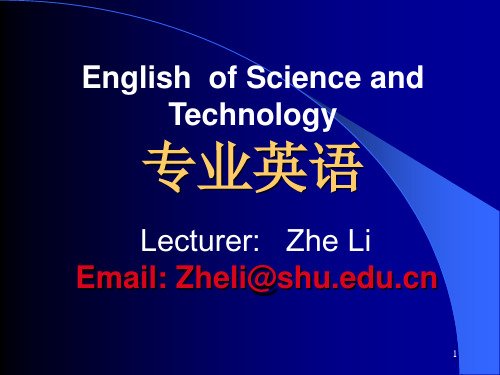
7、省略句
The first treatment would require a minimum of 48 hours, while the second treatment would require only 26 hours. 第一次处理最少需要48小时,而第二次处理只需要26 小时。
11
Dynamics is the study of forces and their effects on the motions of bodies. The cause of acceleration is a force exerted by some external agent or environment. The fundamental properties of force and the relationship between force and acceleration are given by Newton’s three laws of motion. The first of these laws describes the natural state of motion of a free body on which no external forces are acting, whereas the other two laws deal with the behavior of bodies under the influence of force.
3
1. Contents 2. Exams
Classroom participation :50% ; Final exam : 50%
3. Suggestions for You
物理化学专业英语

物理化学专业英语电泳electrophoresis丁达尔效应Dyndall effect定容摩尔热容molar heat capacity under constant volume定容温度计Constant voIume thermometer定压摩尔热容molar heat capacity under constant pressure定压温度计constant pressure thermometer定域子系统localized particle system动力学方程kinetic equations动力学控制kinetics control独立子系统independent particle system对比摩尔体积reduced mole volume对比体积reduced volume对比温度reduced temperature对比压力reduced pressure对称数symmetry number对行反应reversible reactions对应状态原理principle of corresponding state多方过程polytropic process多分子层吸附理论adsorption theory of multi-molecular layers 二级反应second order reaction二级相变second order phase change法拉第常数faraday constant法拉第定律Faraday’s law反电动势back E.M.F.反渗透reverse osmosis反应分子数molecularity反应级数reaction orders反应进度extent of reaction反应热heat of reaction反应速率rate of reaction反应速率常数constant of reaction rate范德华常数van der Waals constant范德华方程van der Waals equation范德华力van der Waals force范德华气体van der Waals gases范特霍夫方程van’t Hoff equation范特霍夫规则van’t Hoff rule范特霍夫渗透压公式van’t Hoff equation of osmotic pressure 非基元反应non-elementary reactions非体积功non-volume work非依时计量学反应time independent stoichiometric reactions 菲克扩散第一定律Fick’s first law of diffusion沸点boiling point沸点升高elevation of boiling point费米-狄拉克统计Fermi-Dirac statistics分布distribution分布数distribution numbers分解电压decomposition voltage分配定律distribution law分散系统disperse system分散相dispersion phase分体积partial volume分体积定律partial volume law分压partial pressure分压定律partial pressure law分子反应力学mechanics of molecular reactions分子间力intermolecular force分子蒸馏molecular distillation封闭系统closed system附加压力excess pressure弗罗因德利希吸附经验式Freundlich empirical formula of adsorption负极negative pole负吸附negative adsorption复合反应composite reaction盖·吕萨克定律Gay-Lussac law盖斯定律Hess law甘汞电极calomel electrode感胶离子序lyotropic series杠杆规则lever rule高分子溶液macromolecular solution高会溶点upper consolute point隔离法the isolation method格罗塞斯-德雷珀定律Grotthus-Draoer’s law隔离系统isolated system根均方速率root-mean-square speed功work功函work content共轭溶液conjugate solution共沸温度azeotropic temperature构型熵configurational entropy孤立系统isolated system固溶胶solid sol固态混合物solid solution固相线solid phase line光反应photoreaction光化学第二定律the second law of actinochemistry光化学第一定律the first law of actinochemistry 光敏反应photosensitized reactions光谱熵spectrum entropy广度性质extensive property广延量extensive quantity广延性质extensive property规定熵stipulated entropy过饱和溶液oversaturated solution过饱和蒸气oversaturated vapor过程process过渡状态理论transition state theory过冷水super-cooled water过冷液体overcooled liquid过热液体overheated liquid亥姆霍兹函数Helmholtz function亥姆霍兹函数判据Helmholtz function criterion 亥姆霍兹自由能Helmholtz free energy亥氏函数Helmholtz function焓enthalpy亨利常数Henry constant亨利定律Henry law恒沸混合物constant boiling mixture恒容摩尔热容molar heat capacity at constant volume恒容热heat at constant volume恒外压constant external pressure恒压摩尔热容molar heat capacity at constant pressure恒压热heat at constant pressure化学动力学chemical kinetics化学反应计量式stoichiometric equation of chemical reaction化学反应计量系数stoichiometric coefficient of chemical reaction 化学反应进度extent of chemical reaction化学亲合势chemical affinity化学热力学chemical thermodynamics化学势chemical potential化学势判据chemical potential criterion化学吸附chemisorptions环境environment环境熵变entropy change in environment挥发度volatility混合熵entropy of mixing混合物mixture活度activity活化控制activation control活化络合物理论activated complex theory活化能activation energy霍根-华森图Hougen-Watson Chart基态能级energy level at ground state基希霍夫公式Kirchhoff formula基元反应elementary reactions积分溶解热integration heat of dissolution吉布斯-杜亥姆方程Gibbs-Duhem equation吉布斯-亥姆霍兹方程Gibbs-Helmhotz equation 吉布斯函数Gibbs function吉布斯函数判据Gibbs function criterion吉布斯吸附公式Gibbs adsorption formula吉布斯自由能Gibbs free energy吉氏函数Gibbs function极化电极电势polarization potential of electrode 极化曲线polarization curves极化作用polarization极限摩尔电导率limiting molar conductivity几率因子steric factor计量式stoichiometric equation计量系数stoichiometric coefficient价数规则rule of valence简并度degeneracy键焓bond enthalpy胶冻broth jelly胶核colloidal nucleus胶凝作用demulsification胶束micelle胶体colloid胶体分散系统dispersion system of colloid胶体化学collochemistry胶体粒子colloidal particles胶团micelle焦耳Joule焦耳-汤姆生实验Joule-Thomson experiment焦耳-汤姆生系数Joule-Thomson coefficient焦耳-汤姆生效应Joule-Thomson effect焦耳定律Joule`s law接触电势contact potential接触角contact angle节流过程throttling process节流膨胀throttling expansion节流膨胀系数coefficient of throttling expansion 结线tie line结晶热heat of crystallization解离化学吸附dissociation chemical adsorption界面interfaces界面张力surface tension浸湿immersion wetting浸湿功immersion wetting work精馏rectify聚(合)电解质polyelectrolyte友情提示:方案范本是经验性极强的领域,本范文无法思考和涵盖全面,供参考!最好找专业人士起草或审核后使用。
(完整版)《物理专业英语》.doc
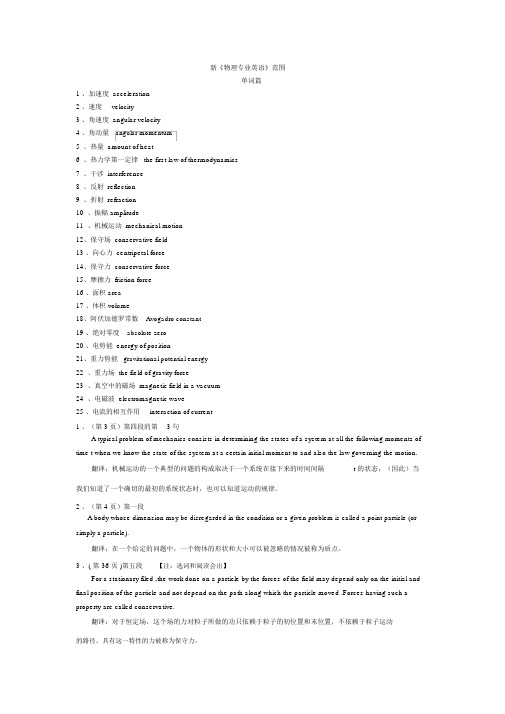
新《物理专业英语》范围单词篇1 、加速度 acceleration2 、速度velocity3 、角速度 angular velocity4 、角动量angular momentum5、热量 amount of heat6、热力学第一定律 the first law of thermodynamics7、干涉 interference8、反射 reflection9、折射 refraction10、振幅 amplitude11、机械运动 mechanical motion12、保守场 conservative field13 、向心力 centripetal force14、保守力 conservative force15、摩擦力 friction force16 、面积 area17 、体积 volume18、阿伏加德罗常数Avogadro constant19 、绝对零度absolute zero20 、电势能 energy of position21、重力势能gravitational potential energy22、重力场 the field of gravity force23、真空中的磁场 magnetic field in a vacuum24、电磁波 electromagnetic wave25 、电流的相互作用interaction of current1 、(第 3 页)第四段的第 3 句A typical problem of mechanics consists in determining the states of a system at all the following moments of time t when we know the state of the system at a certain initial moment to and also the law governing the motion.翻译:机械运动的一个典型的问题的构成取决于一个系统在接下来的时间间隔t 的状态,(因此)当我们知道了一个确切的最初的系统状态时,也可以知道运动的规律。
2016物理专业英语

• Elastic collision a collision in which colliding objects rebound without lasting deformation or the generation of heat • 弹性碰撞 相互碰撞的两物体没有发生行变和热 量 • Inelastic collision a collision in which the colliding objects become distorted and generated heat during the collision • 非弹性碰撞 在碰撞过程中物体变形且产生热量
• • •
Power the time rare of work P=W/t 功率 做功和时间的比值 p=w/t Energy the property of a system that enables it to do work • 能量 可以让它工作的东西
• Sumamry of key Terms • Rotational inertia that property of an object to resist any change in its state of rotation:if at rest the body tends to remain atrest;if rotating,it tends to remain rotaing and will continue to do so unless acted upon by a net extemal torque. • 转动惯量 一个对象的属性来抵抗在旋转 状态下任何改变: 其本身保持静止或一直转动状 态,除非受到外力的干扰。
Friction (摩擦力) The force that opposes the relative motion of contacting media. • 反对接触介质的相对运动的力。 •
物理学专业英语B08

•
v = ωr
B8 Circular motion
• Centripetal acceleration
• Above, a particle is moving in a circle with a steady speed v. The diagram shows how the velocity vector changes direction as the particle moves from P to P' in time δ t.
• Note: • centripetal force is not produced by circular motion. It is the force needed for circular motion. Without it, the object would travel in a straight line.
B8 Circular motion
• Linking v, ω, and r
• Above, a particle is moving in circle with a steady speed v. (It is not a steady velocity because the direction of the velocity vector is changing.) The particle moves a distance S in time t, so: • v =s/t
B8 Circular motion
• Using v = ωr, two more versions of the above equation can be obtained. So:
• For example, if a particle is moving at a steady speed of 3 m s-l in a circle of radius 2 m, its centripetal acceleration a is found using the middle equation: a = 32/2 = 4.5 m s-2. • Note: • When something accelerates, its velocity changes. As velocity is a vector, this can mean a change in speed or direction (or both). Centripetal acceleration is produced by a change in direction, not speed.
物理专业英语_科大版 (1)

中国科技大学物理学院物理学专业英语仅供内部学习参考!2014目录1 Physics 物理学 (1)Introduction to physics (1)Classical and modern physics (2)Research fields (4)V ocabulary (7)2 Classical m echanics 经典力学 (10)Introduction (10)Description of classical mechanics (10)Momentum and collisions (14)Angular momentum (15)V ocabulary (16)3 Thermodynamics 热力学 (18)Introduction (18)Laws of thermodynamics (21)System models (22)Thermodynamic processes (27)Scope of thermodynamics (29)V ocabulary (30)4 Electromagnetism 电磁学 (33)Introduction (33)Electrostatics (33)Magnetostatics (35)Electromagnetic induction (40)V ocabulary (43)5 Optics 光学 (45)Introduction (45)Geometrical optics (45)Physical optics (47)Polarization (50)V ocabulary (51)6 Atomic ph ysics 原子物理 (52)Introduction (52)Electronic configuration (52)Excitation and ionization (56)V ocabulary (59)7 Statistical m echanics 统计力学 (60)Overview (60)Fundamentals (60)Statistical ensembles (63)V ocabulary (65)8 Quantum m echanics 量子力学 (67)Introduction (67)Mathematical formulations (68)Quantization (71)Wave-particle duality (72)Quantum entanglement (75)V ocabulary (77)9 Special r e lativity 狭义相对论 (79)Introduction (79)Relativity of simultaneity (80)Lorentz transformations (80)Time dilation and length contraction (81)Mass-energy equivalence (82)Relativistic energy-momentum relation (86)V ocabulary (89)正文标记说明:蓝色Arial字体(例如energy):已知的专业词汇蓝色Arial字体加下划线(例如electromagnetism):新学的专业词汇黑色Times New Roman字体加下划线(例如postulate):新学的普通词汇1 Physics 物理学Introduction to physicsPhysics is a part of natural philosophy and a natural science that involves the study of matter and its motion through space and time, along with related concepts such as energy and force. More broadly, it is the general analysis of nature, conducted in order to understand how the universe behaves.Physics is one of the oldest academic disciplines, perhaps the oldest through its inclusion of astronomy. Over the last two millennia, physics was a part of natural philosophy along with chemistry, certain branches of mathematics, and biology, but during the Scientific Revolution in the 17th century, the natural sciences emerged as unique research programs in their own right. Physics intersects with many interdisciplinary areas of research, such as biophysics and quantum chemistry,and the boundaries of physics are not rigidly defined. New ideas in physics often explain the fundamental mechanisms of other sciences, while opening new avenues of research in areas such as mathematics and philosophy.Physics also makes significant contributions through advances in new technologies that arise from theoretical breakthroughs. For example, advances in the understanding of electromagnetism or nuclear physics led directly to the development of new products which have dramatically transformed modern-day society, such as television, computers, domestic appliances, and nuclear weapons; advances in thermodynamics led to the development of industrialization; and advances in mechanics inspired the development of calculus.Core theoriesThough physics deals with a wide variety of systems, certain theories are used by all physicists. Each of these theories were experimentally tested numerous times and found correct as an approximation of nature (within a certain domain of validity).For instance, the theory of classical mechanics accurately describes the motion of objects, provided they are much larger than atoms and moving at much less than the speed of light. These theories continue to be areas of active research, and a remarkable aspect of classical mechanics known as chaos was discovered in the 20th century, three centuries after the original formulation of classical mechanics by Isaac Newton (1642–1727) 【艾萨克·牛顿】.These central theories are important tools for research into more specialized topics, and any physicist, regardless of his or her specialization, is expected to be literate in them. These include classical mechanics, quantum mechanics, thermodynamics and statistical mechanics, electromagnetism, and special relativity.Classical and modern physicsClassical mechanicsClassical physics includes the traditional branches and topics that were recognized and well-developed before the beginning of the 20th century—classical mechanics, acoustics, optics, thermodynamics, and electromagnetism.Classical mechanics is concerned with bodies acted on by forces and bodies in motion and may be divided into statics (study of the forces on a body or bodies at rest), kinematics (study of motion without regard to its causes), and dynamics (study of motion and the forces that affect it); mechanics may also be divided into solid mechanics and fluid mechanics (known together as continuum mechanics), the latter including such branches as hydrostatics, hydrodynamics, aerodynamics pneumatics.Acoustics is the study of how sound is produced, controlled, transmitted and received. Important modern branches of acoustics include ultrasonics, the study of sound waves of very high frequency beyond the range of human hearing; bioacoustics the physics of animal calls and hearing, and electroacoustics, the manipulation of audible sound waves using electronics.Optics, the study of light, is concerned not only with visible light but also with infrared and ultraviolet radiation, which exhibit all of the phenomena of visible light except visibility, e.g., reflection, refraction, interference, diffraction, dispersion, and polarization of light.Heat is a form of energy, the internal energy possessed by the particles of which a substance is composed; thermodynamics deals with the relationships between heat and other forms of energy.Electricity and magnetism have been studied as a single branch of physics since the intimate connection between them was discovered in the early 19th century; an electric current gives rise to a magnetic field and a changing magnetic field induces an electric current. Electrostatics deals with electric charges at rest, electrodynamics with moving charges, and magnetostatics with magnetic poles at rest.Modern PhysicsClassical physics is generally concerned with matter and energy on the normal scale ofobservation, while much of modern physics is concerned with the behavior of matter and energy under extreme conditions or on the very large or very small scale.For example, atomic and nuclear physics studies matter on the smallest scale at which chemical elements can be identified.The physics of elementary particles is on an even smaller scale, as it is concerned with the most basic units of matter; this branch of physics is also known as high-energy physics because of the extremely high energies necessary to produce many types of particles in large particle accelerators. On this scale, ordinary, commonsense notions of space, time, matter, and energy are no longer valid.The two chief theories of modern physics present a different picture of the concepts of space, time, and matter from that presented by classical physics.Quantum theory is concerned with the discrete, rather than continuous, nature of many phenomena at the atomic and subatomic level, and with the complementary aspects of particles and waves in the description of such phenomena.The theory of relativity is concerned with the description of phenomena that take place in a frame of reference that is in motion with respect to an observer; the special theory of relativity is concerned with relative uniform motion in a straight line and the general theory of relativity with accelerated motion and its connection with gravitation.Both quantum theory and the theory of relativity find applications in all areas of modern physics.Difference between classical and modern physicsWhile physics aims to discover universal laws, its theories lie in explicit domains of applicability. Loosely speaking, the laws of classical physics accurately describe systems whose important length scales are greater than the atomic scale and whose motions are much slower than the speed of light. Outside of this domain, observations do not match their predictions.Albert Einstein【阿尔伯特·爱因斯坦】contributed the framework of special relativity, which replaced notions of absolute time and space with space-time and allowed an accurate description of systems whose components have speeds approaching the speed of light.Max Planck【普朗克】, Erwin Schrödinger【薛定谔】, and others introduced quantum mechanics, a probabilistic notion of particles and interactions that allowed an accurate description of atomic and subatomic scales.Later, quantum field theory unified quantum mechanics and special relativity.General relativity allowed for a dynamical, curved space-time, with which highly massivesystems and the large-scale structure of the universe can be well-described. General relativity has not yet been unified with the other fundamental descriptions; several candidate theories of quantum gravity are being developed.Research fieldsContemporary research in physics can be broadly divided into condensed matter physics; atomic, molecular, and optical physics; particle physics; astrophysics; geophysics and biophysics. Some physics departments also support research in Physics education.Since the 20th century, the individual fields of physics have become increasingly specialized, and today most physicists work in a single field for their entire careers. "Universalists" such as Albert Einstein (1879–1955) and Lev Landau (1908–1968)【列夫·朗道】, who worked in multiple fields of physics, are now very rare.Condensed matter physicsCondensed matter physics is the field of physics that deals with the macroscopic physical properties of matter. In particular, it is concerned with the "condensed" phases that appear whenever the number of particles in a system is extremely large and the interactions between them are strong.The most familiar examples of condensed phases are solids and liquids, which arise from the bonding by way of the electromagnetic force between atoms. More exotic condensed phases include the super-fluid and the Bose–Einstein condensate found in certain atomic systems at very low temperature, the superconducting phase exhibited by conduction electrons in certain materials,and the ferromagnetic and antiferromagnetic phases of spins on atomic lattices.Condensed matter physics is by far the largest field of contemporary physics.Historically, condensed matter physics grew out of solid-state physics, which is now considered one of its main subfields. The term condensed matter physics was apparently coined by Philip Anderson when he renamed his research group—previously solid-state theory—in 1967. In 1978, the Division of Solid State Physics of the American Physical Society was renamed as the Division of Condensed Matter Physics.Condensed matter physics has a large overlap with chemistry, materials science, nanotechnology and engineering.Atomic, molecular and optical physicsAtomic, molecular, and optical physics (AMO) is the study of matter–matter and light–matter interactions on the scale of single atoms and molecules.The three areas are grouped together because of their interrelationships, the similarity of methods used, and the commonality of the energy scales that are relevant. All three areas include both classical, semi-classical and quantum treatments; they can treat their subject from a microscopic view (in contrast to a macroscopic view).Atomic physics studies the electron shells of atoms. Current research focuses on activities in quantum control, cooling and trapping of atoms and ions, low-temperature collision dynamics and the effects of electron correlation on structure and dynamics. Atomic physics is influenced by the nucleus(see, e.g., hyperfine splitting), but intra-nuclear phenomena such as fission and fusion are considered part of high-energy physics.Molecular physics focuses on multi-atomic structures and their internal and external interactions with matter and light.Optical physics is distinct from optics in that it tends to focus not on the control of classical light fields by macroscopic objects, but on the fundamental properties of optical fields and their interactions with matter in the microscopic realm.High-energy physics (particle physics) and nuclear physicsParticle physics is the study of the elementary constituents of matter and energy, and the interactions between them.In addition, particle physicists design and develop the high energy accelerators,detectors, and computer programs necessary for this research. The field is also called "high-energy physics" because many elementary particles do not occur naturally, but are created only during high-energy collisions of other particles.Currently, the interactions of elementary particles and fields are described by the Standard Model.●The model accounts for the 12 known particles of matter (quarks and leptons) thatinteract via the strong, weak, and electromagnetic fundamental forces.●Dynamics are described in terms of matter particles exchanging gauge bosons (gluons,W and Z bosons, and photons, respectively).●The Standard Model also predicts a particle known as the Higgs boson. In July 2012CERN, the European laboratory for particle physics, announced the detection of a particle consistent with the Higgs boson.Nuclear Physics is the field of physics that studies the constituents and interactions of atomic nuclei. The most commonly known applications of nuclear physics are nuclear power generation and nuclear weapons technology, but the research has provided application in many fields, including those in nuclear medicine and magnetic resonance imaging, ion implantation in materials engineering, and radiocarbon dating in geology and archaeology.Astrophysics and Physical CosmologyAstrophysics and astronomy are the application of the theories and methods of physics to the study of stellar structure, stellar evolution, the origin of the solar system, and related problems of cosmology. Because astrophysics is a broad subject, astrophysicists typically apply many disciplines of physics, including mechanics, electromagnetism, statistical mechanics, thermodynamics, quantum mechanics, relativity, nuclear and particle physics, and atomic and molecular physics.The discovery by Karl Jansky in 1931 that radio signals were emitted by celestial bodies initiated the science of radio astronomy. Most recently, the frontiers of astronomy have been expanded by space exploration. Perturbations and interference from the earth's atmosphere make space-based observations necessary for infrared, ultraviolet, gamma-ray, and X-ray astronomy.Physical cosmology is the study of the formation and evolution of the universe on its largest scales. Albert Einstein's theory of relativity plays a central role in all modern cosmological theories. In the early 20th century, Hubble's discovery that the universe was expanding, as shown by the Hubble diagram, prompted rival explanations known as the steady state universe and the Big Bang.The Big Bang was confirmed by the success of Big Bang nucleo-synthesis and the discovery of the cosmic microwave background in 1964. The Big Bang model rests on two theoretical pillars: Albert Einstein's general relativity and the cosmological principle (On a sufficiently large scale, the properties of the Universe are the same for all observers). Cosmologists have recently established the ΛCDM model (the standard model of Big Bang cosmology) of the evolution of the universe, which includes cosmic inflation, dark energy and dark matter.Current research frontiersIn condensed matter physics, an important unsolved theoretical problem is that of high-temperature superconductivity. Many condensed matter experiments are aiming to fabricate workable spintronics and quantum computers.In particle physics, the first pieces of experimental evidence for physics beyond the Standard Model have begun to appear. Foremost among these are indications that neutrinos have non-zero mass. These experimental results appear to have solved the long-standing solar neutrino problem, and the physics of massive neutrinos remains an area of active theoretical and experimental research. Particle accelerators have begun probing energy scales in the TeV range, in which experimentalists are hoping to find evidence for the super-symmetric particles, after discovery of the Higgs boson.Theoretical attempts to unify quantum mechanics and general relativity into a single theoryof quantum gravity, a program ongoing for over half a century, have not yet been decisively resolved. The current leading candidates are M-theory, superstring theory and loop quantum gravity.Many astronomical and cosmological phenomena have yet to be satisfactorily explained, including the existence of ultra-high energy cosmic rays, the baryon asymmetry, the acceleration of the universe and the anomalous rotation rates of galaxies.Although much progress has been made in high-energy, quantum, and astronomical physics, many everyday phenomena involving complexity, chaos, or turbulence are still poorly understood. Complex problems that seem like they could be solved by a clever application of dynamics and mechanics remain unsolved; examples include the formation of sand-piles, nodes in trickling water, the shape of water droplets, mechanisms of surface tension catastrophes, and self-sorting in shaken heterogeneous collections.These complex phenomena have received growing attention since the 1970s for several reasons, including the availability of modern mathematical methods and computers, which enabled complex systems to be modeled in new ways. Complex physics has become part of increasingly interdisciplinary research, as exemplified by the study of turbulence in aerodynamics and the observation of pattern formation in biological systems.Vocabulary★natural science 自然科学academic disciplines 学科astronomy 天文学in their own right 凭他们本身的实力intersects相交,交叉interdisciplinary交叉学科的,跨学科的★quantum 量子的theoretical breakthroughs 理论突破★electromagnetism 电磁学dramatically显著地★thermodynamics热力学★calculus微积分validity★classical mechanics 经典力学chaos 混沌literate 学者★quantum mechanics量子力学★thermodynamics and statistical mechanics热力学与统计物理★special relativity狭义相对论is concerned with 关注,讨论,考虑acoustics 声学★optics 光学statics静力学at rest 静息kinematics运动学★dynamics动力学ultrasonics超声学manipulation 操作,处理,使用infrared红外ultraviolet紫外radiation辐射reflection 反射refraction 折射★interference 干涉★diffraction 衍射dispersion散射★polarization 极化,偏振internal energy 内能Electricity电性Magnetism 磁性intimate 亲密的induces 诱导,感应scale尺度★elementary particles基本粒子★high-energy physics 高能物理particle accelerators 粒子加速器valid 有效的,正当的★discrete离散的continuous 连续的complementary 互补的★frame of reference 参照系★the special theory of relativity 狭义相对论★general theory of relativity 广义相对论gravitation 重力,万有引力explicit 详细的,清楚的★quantum field theory 量子场论★condensed matter physics凝聚态物理astrophysics天体物理geophysics地球物理Universalist博学多才者★Macroscopic宏观Exotic奇异的★Superconducting 超导Ferromagnetic铁磁质Antiferromagnetic 反铁磁质★Spin自旋Lattice 晶格,点阵,网格★Society社会,学会★microscopic微观的hyperfine splitting超精细分裂fission分裂,裂变fusion熔合,聚变constituents成分,组分accelerators加速器detectors 检测器★quarks夸克lepton 轻子gauge bosons规范玻色子gluons胶子★Higgs boson希格斯玻色子CERN欧洲核子研究中心★Magnetic Resonance Imaging磁共振成像,核磁共振ion implantation 离子注入radiocarbon dating放射性碳年代测定法geology地质学archaeology考古学stellar 恒星cosmology宇宙论celestial bodies 天体Hubble diagram 哈勃图Rival竞争的★Big Bang大爆炸nucleo-synthesis核聚合,核合成pillar支柱cosmological principle宇宙学原理ΛCDM modelΛ-冷暗物质模型cosmic inflation宇宙膨胀fabricate制造,建造spintronics自旋电子元件,自旋电子学★neutrinos 中微子superstring 超弦baryon重子turbulence湍流,扰动,骚动catastrophes突变,灾变,灾难heterogeneous collections异质性集合pattern formation模式形成2 Classical mechanics 经典力学IntroductionIn physics, classical mechanics is one of the two major sub-fields of mechanics, which is concerned with the set of physical laws describing the motion of bodies under the action of a system of forces. The study of the motion of bodies is an ancient one, making classical mechanics one of the oldest and largest subjects in science, engineering and technology.Classical mechanics describes the motion of macroscopic objects, from projectiles to parts of machinery, as well as astronomical objects, such as spacecraft, planets, stars, and galaxies. Besides this, many specializations within the subject deal with gases, liquids, solids, and other specific sub-topics.Classical mechanics provides extremely accurate results as long as the domain of study is restricted to large objects and the speeds involved do not approach the speed of light. When the objects being dealt with become sufficiently small, it becomes necessary to introduce the other major sub-field of mechanics, quantum mechanics, which reconciles the macroscopic laws of physics with the atomic nature of matter and handles the wave–particle duality of atoms and molecules. In the case of high velocity objects approaching the speed of light, classical mechanics is enhanced by special relativity. General relativity unifies special relativity with Newton's law of universal gravitation, allowing physicists to handle gravitation at a deeper level.The initial stage in the development of classical mechanics is often referred to as Newtonian mechanics, and is associated with the physical concepts employed by and the mathematical methods invented by Newton himself, in parallel with Leibniz【莱布尼兹】, and others.Later, more abstract and general methods were developed, leading to reformulations of classical mechanics known as Lagrangian mechanics and Hamiltonian mechanics. These advances were largely made in the 18th and 19th centuries, and they extend substantially beyond Newton's work, particularly through their use of analytical mechanics. Ultimately, the mathematics developed for these were central to the creation of quantum mechanics.Description of classical mechanicsThe following introduces the basic concepts of classical mechanics. For simplicity, it oftenmodels real-world objects as point particles, objects with negligible size. The motion of a point particle is characterized by a small number of parameters: its position, mass, and the forces applied to it.In reality, the kind of objects that classical mechanics can describe always have a non-zero size. (The physics of very small particles, such as the electron, is more accurately described by quantum mechanics). Objects with non-zero size have more complicated behavior than hypothetical point particles, because of the additional degrees of freedom—for example, a baseball can spin while it is moving. However, the results for point particles can be used to study such objects by treating them as composite objects, made up of a large number of interacting point particles. The center of mass of a composite object behaves like a point particle.Classical mechanics uses common-sense notions of how matter and forces exist and interact. It assumes that matter and energy have definite, knowable attributes such as where an object is in space and its speed. It also assumes that objects may be directly influenced only by their immediate surroundings, known as the principle of locality.In quantum mechanics objects may have unknowable position or velocity, or instantaneously interact with other objects at a distance.Position and its derivativesThe position of a point particle is defined with respect to an arbitrary fixed reference point, O, in space, usually accompanied by a coordinate system, with the reference point located at the origin of the coordinate system. It is defined as the vector r from O to the particle.In general, the point particle need not be stationary relative to O, so r is a function of t, the time elapsed since an arbitrary initial time.In pre-Einstein relativity (known as Galilean relativity), time is considered an absolute, i.e., the time interval between any given pair of events is the same for all observers. In addition to relying on absolute time, classical mechanics assumes Euclidean geometry for the structure of space.Velocity and speedThe velocity, or the rate of change of position with time, is defined as the derivative of the position with respect to time. In classical mechanics, velocities are directly additive and subtractive as vector quantities; they must be dealt with using vector analysis.When both objects are moving in the same direction, the difference can be given in terms of speed only by ignoring direction.AccelerationThe acceleration , or rate of change of velocity, is the derivative of the velocity with respect to time (the second derivative of the position with respect to time).Acceleration can arise from a change with time of the magnitude of the velocity or of the direction of the velocity or both . If only the magnitude v of the velocity decreases, this is sometimes referred to as deceleration , but generally any change in the velocity with time, including deceleration, is simply referred to as acceleration.Inertial frames of referenceWhile the position and velocity and acceleration of a particle can be referred to any observer in any state of motion, classical mechanics assumes the existence of a special family of reference frames in terms of which the mechanical laws of nature take a comparatively simple form. These special reference frames are called inertial frames .An inertial frame is such that when an object without any force interactions (an idealized situation) is viewed from it, it appears either to be at rest or in a state of uniform motion in a straight line. This is the fundamental definition of an inertial frame. They are characterized by the requirement that all forces entering the observer's physical laws originate in identifiable sources (charges, gravitational bodies, and so forth).A non-inertial reference frame is one accelerating with respect to an inertial one, and in such a non-inertial frame a particle is subject to acceleration by fictitious forces that enter the equations of motion solely as a result of its accelerated motion, and do not originate in identifiable sources. These fictitious forces are in addition to the real forces recognized in an inertial frame.A key concept of inertial frames is the method for identifying them. For practical purposes, reference frames that are un-accelerated with respect to the distant stars are regarded as good approximations to inertial frames.Forces; Newton's second lawNewton was the first to mathematically express the relationship between force and momentum . Some physicists interpret Newton's second law of motion as a definition of force and mass, while others consider it a fundamental postulate, a law of nature. Either interpretation has the same mathematical consequences, historically known as "Newton's Second Law":a m t v m t p F ===d )(d d dThe quantity m v is called the (canonical ) momentum . The net force on a particle is thus equal to rate of change of momentum of the particle with time.So long as the force acting on a particle is known, Newton's second law is sufficient to。
物理学专业英语A1课件

• • average speed = •
displacement time taken
• The SI unit of velocity is also the m s-1. But unlike speed, velocity is a vector.
5
A1 Motion,mass,and forces
when the ball below has returned to its starting point, its vertical displacement is zero. However, the distance travelled is 10m.
5m
ball thrown up from here
•
12m
•
A
B
• The arrow above represents the displacement of a particle which moves 12m from A to B. However, with horizontal or vertical motion, it is often more convenient to use a ‘+’ or ‘-’ to show the vector direction. For example:
=gradient =- 6/2 =- 3ms-2
=3ms-2
velocity in m s-1
0
2 time in s 4
6
• On the velocity-time graph above, you can work out the acceleration
over each section by finding the gradient of the line. The gradient is
物理学专业英语A2
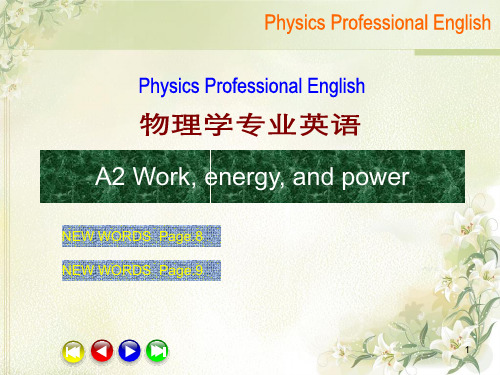
A2 Work, energy, and power
Calculating potential energy (PE) • The stone above has potential energy. This is equal to the work done in lifting it to a height h above the ground. • The stone, mass m, has a weight of mg. • So the force needed to overcome gravity and lift it is mg. • • • • • As the stone is Iifted through a height h: work done = force x distance moved = mg x h So potential energy = mgh For example, if a 2 kg stone is 5 m above the ground, and g is 10 N kg-1, then the stone's PE = 2 x 10 x 5 = 100 J.
10
A2 Work, energy, and power
vectors, scalars, and energy • Vectors have magnitude and direction. When adding vectors, you must allow for their direction. In A1, for example, there are diagrams showing two 6 N forces being added. In one, the resultant is 12 N. In the other, it is zero. • Scalars are quantities which have magnitude but no direction. Examples include mass, volume, energy, and work. Scalar addition is simple. If 6 kg of mass is added to 6 kg of mass, the result is always 12 kg. Similarly, if an object has 6 J of PE and 6 J of KE, the total energy is 12 J. • As energy is a scalar, PE and KE can be added without allowing for direction. The stone on the right has the same total PE + KE throughout its motion. As it starts with the same PE as the stone in the previous diagram, it has the same KE (and speed) when it is about to hit the ground.
物理专业英语
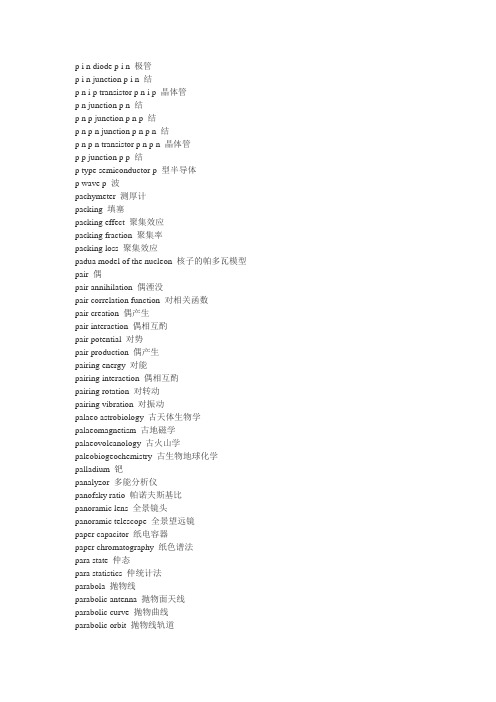
p i n diode p i n 极管p i n junction p i n 结p n i p transistor p n i p 晶体管p n junction p n 结p n p junction p n p 结p n p n junction p n p n 结p n p n transistor p n p n 晶体管p p junction p p 结p type semiconductor p 型半导体p wave p 波pachymeter 测厚计packing 填塞packing effect 聚集效应packing fraction 聚集率packing loss 聚集效应padua model of the nucleon 核子的帕多瓦模型pair 偶pair annihilation 偶湮没pair correlation function 对相关函数pair creation 偶产生pair interaction 偶相互酌pair potential 对势pair production 偶产生pairing energy 对能pairing interaction 偶相互酌pairing rotation 对转动pairing vibration 对振动palaeo astrobiology 古天体生物学palaeomagnetism 古地磁学palaeovolcanology 古火山学paleobiogeochemistry 古生物地球化学palladium 钯panalyzor 多能分析仪panofsky ratio 帕诺夫斯基比panoramic lens 全景镜头panoramic telescope 全景望远镜paper capacitor 纸电容器paper chromatography 纸色谱法para state 仲态para statistics 仲统计法parabola 抛物线parabolic antenna 抛物面天线parabolic curve 抛物曲线parabolic orbit 抛物线轨道parabolic potential 抛物线势parabolic reflector 抛物面反射器parabolic type 抛物型paraboloid 抛物面paraboloid of revolution 回转抛物面paracrystal 仲晶paradox 佯谬parahelium 仲氦parahydrogen 仲氢parallactic angle 视差角parallactic ellipse 视差椭圆parallactic motion 视差动parallax 视差parallel circuit 并联电路parallel connection 并联parallel cut y 切割parallel displacement 平行位移parallel plate capacitor 平行板形电容器parallel plate condenser 平行板形电容器parallelogram of forces 力平行四边形paramagnet 顺磁体paramagnetic absorption 顺磁性吸收paramagnetic element 顺磁性元素paramagnetic material 顺磁物质paramagnetic relaxation 顺磁弛豫paramagnetic resonance 顺磁共振paramagnetic resonance absorption 顺磁共振吸收paramagnetic substance 顺磁物质paramagnetic susceptibility 顺磁磁化率paramagnetism 顺磁性paramagnon 顺磁振子parameter 参量parameter of state 态变数parametric amplifier 参量放大器parametric excitation 参量激发parametron 参数器parasitic ferromagnetism 寄生铁磁性parasitic oscillation 寄生振荡parasitic resonance 寄生共振paraterm 仲项paraxial rays 近轴光线parent element 母元素parent mass peak 原始峰parent peak 原始峰parhelium 仲氦parity 宇称parity conservation law 宇称守恒律parity violation 宇称不守恒parsec 秒差距partial dislocation 分位错partial equilibrium 部分平衡partial polarization 部分偏振partial pressure 分压partial wave 分波partial wave analysis 分波分析partial wave expansion 分波展开partially conserved axial vector current 轴矢量分守恒partially polarized light 部分偏振光particle 粒子particle acceleration 粒子加速particle accelerator 粒子加速器particle antiparticle conjugation 正反粒子共轭particle aspect of matter 物质的粒子观点particle beam 粒子束particle booster 注入加速器particle collisions 粒子碰撞particle concentration 粒子浓度particle counter 粒子计数器particle hole interaction 粒子空穴相互酌particle hole theory 粒子空穴理论particle hole transformation 粒子空穴变换particle particle correlation 粒子粒子相关particle separation 粒子分离particle separator 粒子分离器particle track detector 粒子径迹探测器particle transfer reaction 粒子转移反应partition function 统计和parton model 部分子模型pascal 帕pascal's principle 帕斯卡原理paschen back effect 帕邢巴克效应paschen runge mounting 帕邢朗格装置paschen series 帕邢系passive electric circuit 无源电路passive network 无源网络passive state 被动状态passivity 被动状态path 路径path difference 程差path integral 路径积分path of vision 视线path tracking 跟踪飞行轨道pattern 图形pattern recognition 图样识别patterson function 帕特森函数patterson method 帕特森方法pauli approximation 泡利近似pauli exclusion principle 泡利不相容原理pauli matrix 泡利矩阵pauli paramagnetism 泡利顺磁性pauli principle 泡利不相容原理pauli spinor 泡利旋量pauli villars regularization 泡利维拉斯正规化pavo 孔雀座peak 峰peak energy 峰值能量峰peak power 峰值功率peak voltage 峰压pearl necklace model 珍珠颈挂式模型peculiar galaxy 特殊星系peculiar minor planet 特殊小行星pegasus 飞马座peierls potential 佩尔斯势peierls transition 佩尔斯跃迁pellet compression 靶丸压缩pellet implosion 靶丸爆聚pellets 靶丸peltier effect 珀耳帖效应pencil 束pencil beam survey 深巡天pencil of light 光束pendular oscillation 摆振动pendulum 摆pendulum clock 摆钟penetrability 贯穿性penetrating power 贯穿本领penetrating shower 贯穿簇射penetration depth 穿透深度penetration depth of london 伦敦穿透深度penetrometer 透度计penning discharge 彭宁放电penning effect 彭宁效应penning gage 彭宁真空计penning ion source 彭宁离子源penning ionization 彭宁电离penrose diagramm 彭罗斯图形penrose lattice 彭罗斯点阵penrose tile 彭罗斯点阵pentagonal prism 五角棱镜pentane lamp 戊烷灯pentode 五极管pentration 贵穿penumbra 半影percent 百分率percolating network 渗透网络percolation 渗滤percussion 冲击perfect conductivity 理想导电性perfect conductor 理想导体perfect cosmological principle 完全宇宙原理perfect crystal 理想晶体perfect diamagnetism 理想抗磁性perfect elasto plastic body 完全弹塑性体perfect fluid 完全铃perfect gas 理想气体perfect liquid 理想液体perfect polarization 全极化perfect solution 理想溶液perfectly black body 绝对黑体perfectly elastic body 完全弹性体perfectly elastic collision 完全弹性碰撞perfectly inelastic collision 完全非弹性碰撞period 周期period luminosity relation 周期光度关系period of oscillation 振荡周期period of revolution 公转周期periodic comet 周期彗星periodic error 周期误差periodic law 周期律periodic motion 周期运动periodic orbit 周期轨道periodic potential 周期势periodic system 周期系periodic table 周期表periodic zone 周期带peripheral collision 边缘碰撞peripheral reaction 圆周反应peripheral vision 周边视觉periscope 潜望镜permalloy 坡莫合金permanent magnet 永磁铁permeability 磁导率permeameter 磁导计permeance 磁导permissible dose 容许剂量permissible error 容许误差permissible stress 容许应力permissible tolerance 容许剂量permitted line 容许谱线permittivity 介电常数permutation 排列permutation group 置换群permutation operator 置换算符perovskite structure 钙钛矿型结构perpendicular band 正交带perpendicular susceptibility 垂直磁化率perpetual mobile 永恒机关perpetual motion 永恒运动perpetuum mobile 永动机perpetuum mobile of the first kind 第一类永动机perpetuum mobile of the second kind 第二类永动机perseus 英仙座persistence of vision 视觉暂留persistent current 持久电流persistent line 暂留谱线personal computer 个人计算机personal error 人为误差personal monitor 个人剂量计personal monitoring 个人监测perturbation 微扰perturbation energy 微扰能perturbation method 摄动法perturbation theory 微扰理论perturbed motion 受摄运动perveance 电子管导电系数peta 拍它petra 正负电子串列存储环型加速器petrapfund series 芬德系phantom 人体模型phase 相位phase advance capacitor 相位超前电容器phase angle 相位角phase average 相平均phase boundary 相界phase coherent state 相位相干态phase conjugate interferometry 相位共轭干涉法phase contrast 相衬phase contrast method 相衬法phase contrast microscope 相衬显微镜phase diagram 平衡图phase difference 相位差phase discriminator 相位鉴别器鉴相器phase displacement 相移phase distortion 相位畸变phase equilibrium 相平衡phase grating 相位衍射光栅phase hologram 相位全息图phase locked loop 锁相环路phase locking 锁相phase locking technique 锁相法phase margin 相位容限phase matching 相位平衡phase meter 功率因数计phase mode 相位模phase modulation 掂phase orbit 相轨道phase oscillation 相位振动phase retrieval 相位复原phase rule 相律phase sensitive detection 相敏检波phase separation 相分离phase shift 相移phase shift oscillator 相移振荡器phase shifter 移相器phase space 相宇phase space average 相平均phase stability 相位稳定性phase transformation 相变phase transition 相变phase transition of the first kind 第一类相变phase transition of the second kind 第二类相变phase transition of vacuum 真空相变phase velocity 相速度phase voltage 相电压phase volume 相体积phason 起伏量子phasotron 稳相加速器phenomenon 现象phoenix 凤凰座phon 方phonometer 声响度计phonon 声子phonon drag 声子曳引phonon echo 声子回波phonon excitation 声子激发phosphor 磷光体phosphorescence 磷光phot 辐透photo acoustic spectroscopy 光声光谱学photo magnetoelectric effect 光磁电效应photoacoustics 光声学photoactivation 光激活photobiology 光生物学photocathode 光电阴极photocell 光电池photoceram 光敏玻璃陶瓷photochemical reaction 光化反应photochemical system 光化学系统photochemistry 光化学photochromic glass 光变色玻璃photocolorimeter 光电比色计photoconduction 光电导photoconductive cell 光电导管photoconductive effect 内光电效应photoconductivity 光电导性photocurrent 光电流photodensitometer 光密度计photodensitometry 光密度分析法photodetachment 光致脱离photodetector 光探测器photodiode 光电二极管photoeffect 光电效应photoelastic effect 光弹性效应photoelastic holography 光弹性全息照相photoelasticimeter 光致弹性测量计photoelasticity 光弹性photoelectret 光永电体photoelectric absorption 光电吸收photoelectric cell 光电池photoelectric current 光电流photoelectric effect 光电效应photoelectric emission 光电发射photoelectric microphotometer 光电测微光度计photoelectric photometer 光电光度计photoelectric photometry 光电测光photoelectric pyrometer 光电高温计photoelectric threshold 光电阈photoelectric tube 光电管photoelectricity 光电photoelectromagnetic effect 光电磁效应photoelectron 光电子photoelectron spectroscopy 光电子谱学photoemission 光电发射photoexcitation 光激发photofission 光核裂变photogalvanic effect 光生伏打效应photographic apparatus 照相机photographic camera 照相机photographic density 照相密度photographic emulsion 照相乳胶photographic film 软片photographic lens 照相物镜photographic magnitude 照相星等photographic material 照相材料photographic photometry 照相测光学photographic plate 照相底板photographic telescope 天体照相机photography 照相术photogun 光电子枪photoionization 光致电离photoirradiation 光致辐照photoluminescence 光致发光photolysis 光解酌photomagnetic effect 光磁效应photometer 光度计photometric cube 光度计立方体photometric distance 测光距离photometric elements 测光要素photometric quantity 光度量photometric standard 光度学标准photometric unit 光度单位photometric wedge 测光楔photometrical paradox 奥伯斯佯谬photometry 光度学photomicrograph 显微镜照片photomicroscopic 显微照相机photomultiplier 光电倍增管photomultiplier tube 光电倍增管photon 光子photon counting method 光子计数法photon coupled pair 光导发光元件photon echo 光子回波photon gas 光子气体photon packet 光子束photonegative effect 负光电效应photoneutron 光中子photonuclear fission 光核裂变photonuclear reaction 光核反应photophoresis 光致迁动photopic vision 亮视觉photoplate 照相底板photoradiometer 光辐射计photorecorder 自动记录照相机photoresist 光致抗蚀剂photosemiconductor 光半导体photosensitive resin 光敏尸photosensitivity 光灵敏度photosensitization 光敏化photosphere 光球photostatistics 光子统计学photosynthesis 光合酌phototelegraphy 传真photothermal displacement 光照位移phototransistor 光电晶体管photovisual magnitude 仿视星等photovoltaic effect 光生伏打效应physical chaos 物理混沌physical chemistry 物理化学physical constant 物理常数physical double star 物理双星physical libration 物理天平动physical mathematics 物理数学physical oceanography 海洋物理学physical optics 物理光学physical pendulum 复摆physical photometer 物理光度计physical photometry 物理光度学physical property 物理性质physical quantity 物理量physical roentgen equivalent 物理伦琴当量physical variable 物理变星physicist 物理学家physico chemical 物理化学的physics 物理学physics of heat 热物理学physics of metals 金属物理学physiological acoustics 生理声学pi bond 键pi electron 电子pi electron approximation 电子近似pi meson 介子pi orbital 轨道pick up reaction 拾取反应pico 微微picofarad 微微法picosecond 微微秒picosecond laser 微微秒激光器picosecond light pulse 微微秒光脉冲picosecond spectroscopy 微微秒光谱学pictor 绘架座pid action 比例积分微分酌pierce type crystal oscillator 皮尔斯石英振荡器pierce type electron gun 皮尔斯电子枪piezo ceramic element 压电陶瓷元件piezo semiconductor transducer 压电半导体换能器piezoceramics 压电陶瓷piezochromism 受压变色piezoelectric 压电piezoelectric actuator 压电传动装置piezoelectric axis 压电轴piezoelectric constant 压电常数piezoelectric crystal 压电晶体piezoelectric effect 压电效应piezoelectric element 压电元件piezoelectric loudspeaker 压电扬声器piezoelectric modulus 压电模量piezoelectric oscillator 压电振荡器piezoelectric polaron 压电极化子piezoelectric transducer 压电转换器piezoelectric vibration 压电振动piezoelectricity 压电piezometer 液体压力计piezoresistor 压电电阻器piezotropy 压性pile 反应堆pile oscillator 反应堆振荡器pile up effect 脉冲堆积效应pilot lamp 指示灯pinch effect 箍缩效应pinching 自压缩pinhole camera 针孔照相机pinning 锁住pinning center 锁住中心pinning force 锁住力pinning potential 锁住势pion 介子pion beam 介子束pion condensation 介子凝聚pionic atom 介原子pionization 介子化过程pipe 导管pipe line 导管pippard equation 皮帕德方程pirani gage 皮拉尼压力计pisces 双鱼座piscis austrinus 南鱼座pitot tube 皮托管planar transistor 平面晶体管planck mass 普朗克质量planck time 普朗克时间planck's constant 普朗克常数planck's function 普朗克函数planck's fundamental length 普朗克基本长度planck's law of radiation 普朗克辐射定律plane concave lens 平凹透镜plane convex lens 平凸透镜plane fault 面缺陷plane grating 平面光栅plane mirror 平面镜plane of incidence 入射面plane of polarization 偏光面plane of projection 射影平面plane of symmetry 对称面plane polarization 平面偏振plane polarized light 平面偏振光plane polarized wave 平面偏振波plane wave 平面波planet 行星planetarium 天象仪planetary aberration 行星光行差planetary cosmogony 行星演化学planetary geology 行星地质学planetary nebula 行星状星云planetary system 行星系planetesimal theory 星子论planetesimals 星子planetoid 小行星planimeter 测面仪plano concave lens 平凹透镜plano convex lens 平凸透镜plano cylindrical lens 平圆柱透镜plano spherical lens 平面球面透镜plasma 等离子体plasma accelerator 等离子体加速器plasma balance 等离子体平衡plasma cluster 等离子粒团plasma confinement 等离子体禁闭plasma containment 等离子体禁闭plasma diagnostics 等离子体诊断学plasma dispersion function 等离子体弥散函数plasma echo 等离子体回波plasma engine 等离子体发动机plasma focus 等离子体聚焦点plasma frequency 等离子体频率plasma gun 等离子体枪plasma heating 等离子体加热plasma instability 等离子体不稳定性plasma membrane 原生质膜plasma oscillation 等离子体振荡plasma physics 等离子体物理学plasma potential 等离子体势plasma source 等离子体源plasma wave 等离子体波plasmapause 等离子体层顶plasmasphere 等离子层plasmoid 等离子粒团plasmon 等离振子plasmon excitation 等离振子激发plastic anisotropy 塑性蛤异性plastic deformation 塑性变形plastic flow 塑性怜plastic material 塑胶plastic potential 塑性势plastic wave 塑性波plastic yield 塑性屈服plasticity 塑性plastics 塑胶plate 正极plate battery 阳极电池组plate circuit 板极电路plate current 板极电流plate detection 板极检波plate resistance 板极电阻plate tectonics 板块构造plate voltage 板极电压plateau 坪platinum 铂platinum group elements 铂族元素platinum resistance thermometer 铂电阻温度计pleochroic halo 多向色晕pleochroism 多色性pleochromatism 多色性plk method plk 法plot 标绘plotter 标绘器plug 插头plural scattering 多重散射plus 加plus sign 加号pluto 冥王星plutonium 钚plutonium reactor 钚堆plutonium regeneration 钚再生pluviometer 雨量器pneumatic laser 气动激光器pockels cell 波克尔斯盒pocket dosimeter 袖珍剂量计pocket of air 气囊point at infinity 无穷远点point charge 点电荷point contact rectifier 点接触整流point contact transistor 点接触晶体管point defect 点缺陷point discharge 尖端放电point group 点群point lattice 点晶格point of action 酌点point of application 酌点point of contact 接触点point source of light 点光源poise 泊poiseuille flow 泊萧叶怜poiseuille's law 泊萧叶定律poisson bracket 泊松括号poisson equation 泊松方程poisson process 泊松过程poisson's ratio 泊松比polar aurora 极光polar binding 极性键polar bond 极性键polar cap 极冠polar cap absorption 极冠吸收polar crystal 极性晶体polar gas 极性气体polar light 极光polar liquid 极性液体polar molecule 极性分子polar motion 极运动polar sequence 北极星序polar telescope 天极仪polar triangle 极三角形polar vector 极矢量polar wandering 极运动polar year 极年polarimeter 偏振计polarimetry 测偏振术polaris 北极星polarisation angle 布儒斯特偏振角polariscope 偏振光镜polariton 电磁耦合振子polarity 极性polarizability 极化率polarizability ellipsoid 极化率椭球polarization 极化polarization charge 极化电荷polarization current 极化电流polarization curve 极化曲线polarization factor 极化因数polarization filter 偏振滤光镜polarization force 极化力polarization interferometer 偏振干涉仪polarization microscope 偏光显微镜polarization of neutron 中子的极化polarization orbital 极化轨道polarization potential 极化势polarization spectroscopy 偏振光光谱学polarized beam 极化束polarized ion source 极化离子源polarized light 偏振光polarized neutron diffraction technique 极化中子衍射法polarized nucleus 极化核polarized raman scattering 偏振喇曼散射polarized relay 极化继电器polarized target 极化靶polarizer 起偏器偏振器polarizing filter 偏振滤光镜polarizing microscope 偏光显微镜polarizing prism 偏振棱镜polarograph 极谱仪polarography 极谱学polaroid 偏光片polaron 极化子pole 极pole of ecliptic 黄极pole piece 极片pole shoe 极片pole strength 磁极强度polestar 北极星polhode 心迹线polishing 抛光poloidal magnetic field 极向磁场polonium 钋polyatomic molecule 多原子分子polycondensation 缩聚酌polycrystal 多晶polycrystalline material 多晶物质polydisperse system 多色散系polygon of forces 力多边形polygonization 多边形化polymer 聚合物polymer complex 聚合络合物polymer crystal 聚合晶体polymer effect 聚合效应polymerization 聚合polymerization of protein 蛋白质聚合polymolecularity 多分子性polymorphism 多形性polyphase 多相polyphase current 多相电流polytrope 多变性polytropic change 多方状态变化polytropic index 多方指标polytropic process 多变过程pomeranchuk effect 坡密朗丘克效应pomeranchuk theorem 坡密兰丘克定理pomeron 坡密子pool type reactor 池式堆population 全域population inversion 粒子数反转pore 小黑子porosity 多孔性porous flow 多孔流position 位置position resolution 位置分辨率position sensitive detector 对位置灵敏的探测器position vector 位置矢量positive 正片positive charge 正电菏positive column 阳极区positive crystal 正晶体positive electricity 正电positive electrode 阳极positive electron 正电子positive element 正元素positive eyepiece 正目镜positive feedback 正反馈positive hole 空子positive ion 阳离子positive lens 正透镜positive magnetostriction 正磁致伸缩positive meniscus 凹凸透镜positive meson 正介子positive rays 阳射线positon 正电子positron 正电子positron annihilation 正电子湮没positron beam 正电子束positron channeling 正电子沟道positron electron annihilation 偶湮没positron electron tandem ring accelerator 正负电子串列存储环型加速器petra positron emission 正电子发射positron factory 正电子工厂positron spectroscopy 正电子谱学positronium 电子偶素post newtonian approximation 后牛顿近似post nova 燃后新星post post newtonian approximation 后后牛顿近似potassium 钾potassium dihydrogenphosphate 磷酸二氢钾potential 势potential barrier 势垒potential difference 势差potential divider 分压器potential energy 势能potential energy curve 势能曲线potential field 势场potential flow 势流potential function 势函数potential instability 对粱稳定性potential motion 势运动potential scattering 势散射potential well 势阱potentiometer 电位计potts model 波特模型pound 磅powder camera 粉末照相机powder diffraction method 粉末法powder pattern 粉末干涉象powder photography 粉末照相术power 功率power amplification 功率放大power demonstration reactor 动力示范堆power density 功率密度power dissipation 耗散功率power factor 功率因数power factor meter 功率因数计power gain 功率增益power of a lens 透镜的焦强power reactor 动力堆power tube 功率管poynting robertson effect 坡印廷罗伯逊效应poynting's vector 坡印廷矢量practical system of units 实用单位制prandtl number 普朗特数praseodymium 镨pre vacuum 初真空pre vacuum pump 预备真空泵preacceleration 预加速preaccelerator 前加速器preamplifier 前置放大器precession 旋进precession camera 旋进照相机precession of orbit 轨道旋进precessional constant 岁差常数precious metal 贵金属precipitation 沉淀precision 精密度precision measurement 精密测量predict earthquake with catfish 用鲶鱼预报地震prediction 预报prediction of solar activity 太阳活动预告predissociation 预离解preferential recombination 优选复合preionization 预电离preliminary vacuum 初真空pressure 压力pressure broadening 压力增宽pressure coefficient 压力系数pressure dispersion 压力弥散pressure drag 压力阻pressure drop 压降pressure gage 压力表pressure head 压头pressure height equation 气压测高公式pressure of light 光压pressure of water vapor 水汽压pressure sensitive diode 压力敏感二极管pressure sensitive transistor 压力敏感晶体管pressure tensor 压强张量pressurized air 压缩空气pressurized water reactor 压水堆primakoff effect 普里马科夫效应primary battery 原电池primary beam 初级束流原射线束primary cell 原电池primary circuit 原电路primary colors 原色primary cosmic radiation 原宇宙辐射primary cosmic rays 原宇宙射线primary electron 原电子primary energy 一次能量primary ionization 一次电离primary rainbow 昼primary recrystallization 一次再结晶primary standard 原标准primary star 智primary target 初始靶primary thermometer 初始温度计primary voltage 初级电压prime meridian 零子午线prime vertical 卯酉圈primeval galaxy 原始星系primitive black hole 原始黑洞primitive lattice 初基点阵primordial solar nebula 太阳系星云principal axes of stress 应力轴principal axis 轴principal axis of inertia 惯性轴principal index for extraordinary ray 非常光线舟射率principal moment of inertia 知动惯量principal plane 纸面principal point 帚principal quantum number 挚子数principal ray 肘线principal refractive indices 舟射率principal series 诌系principal stress 枝力principle 原理principle of constancy of light velocity 光速不变原理principle of corresponding states 对应态原理principle of detailed balancing 细致平衡原理principle of entropy compensation 熵补偿原理principle of equal a priori probabilities 等验前概率原理principle of equipartition 均分原理principle of equivalence 等价原理principle of equivalence of mass and energy 质能当量原理principle of indeterminancy 测不准原理principle of least action 最小酌原理principle of least constraint 最小约束运动原理principle of microscopic reversibility 微观可逆性原理principle of minimum dissipation of energy 最小能量耗散原理principle of relativity 相对性原理principle of reversibility 可逆性原理principle of superposition 叠加原理principle of virtual displacement 虚位移原理principle of virtual work 虚功原理printed board 印刷电路板printed circuit 印刷电路printer 打印机prism 棱镜prism angle 棱镜角prism spectrograph 棱镜摄谱仪prism spectroscope 棱镜分光镜prismatic transit instrument 折轴中星仪probability 概率probability current density 概率淋度probability density 概率密度probability distribution 概率分布probability distribution function 概率分布函数probability function 概率函数probability of collision 碰撞概率probable error 概率误差probe 探头probe charge 试探电荷probe method 探测法problem of three bodies 三体问题process control 过程控制product nucleus 生成核production 产生production of entropy 熵产生profile drag 翼型阻力profile monitor 剖面监测器prognosis 预报program 程序program library 程序库programme 程序programming language 程序设计语言progressive wave 前进波projecting lens 投影透镜projection 投影projection of crystal 晶体投影projection operator 投影算符projector 投影器幻灯promethium 钷prominence 日珥prominence spectroscope 日珥分光镜prompt neutron 瞬发中子propagation 传播propagation constant 传播常数propagation of sound 声传播propagation velocity 传播速度propagator 传播函数proper channeling 本盏道proper field 固有场proper lorentz group 固有洛伦兹群proper motion 自行proper time 原时proper tone 固有音proper value 本盏proportion 比例proportional component 比例分量proportional counter 正比计数管proportional ionization chamber 正比电离室proportionality factor 比例系数protoatmosphere 原大气protocol 协议proton 质子proton accelerator 质子加速器proton antiproton collision 质子反质子碰撞proton decay 质子衰变proton induced x ray analysis 质子激发x 射线分析proton linear accelerator 质子直线加速器proton number 质子数proton spectrometer 质子谱仪proton synchrotron 质子同步加速器protoplanet 原行星protostar 原恒星protosun 原太阳prototype 原型prototype meter 米原器proximity 附近proximity effect 邻近效应proximity switch 接近开关pseudo crossing 伪交叉pseudo crystal 伪晶体pseudo dipole interaction 伪偶极子相互酌pseudo energy gap 伪能隙pseudo equilibrium 伪平衡pseudo image 假象pseudo plastic flow 伪塑性流pseudo scalar 伪标量pseudo scalar coupling 伪标量耦合pseudo scalar meson 伪标介子pseudo tensor 伪张量pseudo vector 伪矢量pseudo vector coupling 伪矢量耦合pseudo wave 伪波pseudopotential 伪势pseudostate 伪态pseudosymmetry 伪对称pseudovariable 准变星pss method pss 法psychoacoustics 心理声学psychobiophysics 心理生物物理学psychorheology 心理龄学psychrometer 干湿表ptolemaic system 托勒玫体系pulsar 脉冲星pulsating current 脉动电流pulsating star 脉动星pulsating universe 振动宇宙pulsating variable 脉动星pulsating voltage 脉动电压pulsation 脉动pulse 脉冲pulse amplifier 脉冲放大器pulse code modulation 脉冲编码灯pulse coincidence 脉冲符合pulse decay 脉冲衰减pulse discharge 脉冲放电pulse duration 脉冲持续时间pulse generator 脉冲发生器pulse height 脉冲高度pulse height analyzer 脉冲高度分析器pulse height discriminator 脉冲高度鉴别器pulse height selector 脉冲高度选择器pulse interval 脉冲间隔pulse laser 脉冲激光pulse length 脉冲宽度pulse modulation 脉冲灯pulse motor 脉冲电动机pulse neutron source 脉冲式中子源pulse oscillator 脉冲发生器pulse recurrence frequency 脉冲重复频率pulse repetition frequency 脉冲重复频率pulse shape 脉冲波形pulse shape discriminator 脉冲波形鉴别器pulse shaper 脉冲成形器pulse shaping 脉冲成形pulse spacing 脉冲间隔pulse transformer 脉冲变压器pulse width 脉冲宽度pulse x rays 脉冲x 射线pulsed cyclotron 脉冲回旋加速器pulsed ion source 脉冲离子源pulsed neutron beam 脉冲中子束pulsimeter 脉冲计数器pump 泵pumping 抽运pumping speed 抽速punctum remotum 远点pupil 光瞳pupillary aperture 光瞳孔径puppis 船尾座pure scattering 纯散射pure state 纯态pure tone 纯音purgemeter 微量量计purity 纯度purple light 柴光push button 按钮push pull 推挽式push pull amplifier 推挽放大器pycnometer 比重瓶pyrex glass 派热克斯玻璃pyrgeometer 地面辐射表pyrheliometer 直接日射强度计pyroelectricity 热电pyrogeology 火山学pyrology 热学pyromagnetism 高温磁学pyrometer 高温计pyrometric cone 测温锥pyrometry 高温测定法pyxis 罗盘座。
物理学类专业英语_基础课程
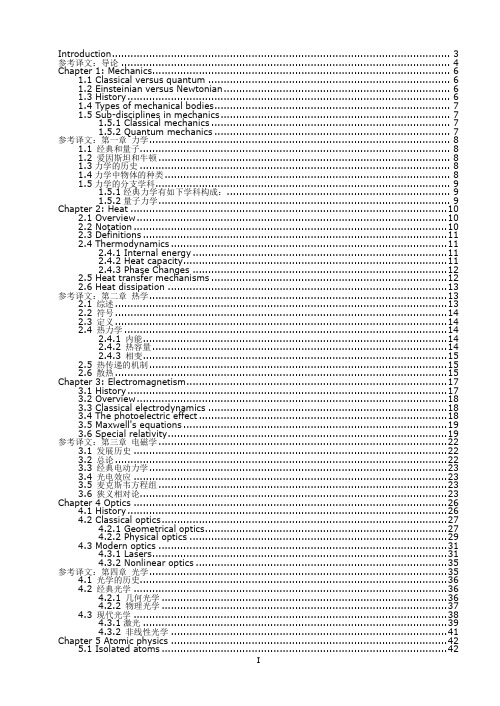
Introduction (3)参考译文:导论 (4)Chapter 1: Mechanics (6)1.1 Classical versus quantum (6)1.2 Einsteinian versus Newtonian (6)1.3 History (6)1.4 Types of mechanical bodies (7)1.5 Sub-disciplines in mechanics (7)1.5.1 Classical mechanics (7)1.5.2 Quantum mechanics (7)参考译文:第一章力学 (8)1.1 经典和量子 (8)1.2 爱因斯坦和牛顿 (8)1.3力学的历史 (8)1.4力学中物体的种类 (8)1.5力学的分支学科 (9)1.5.1经典力学有如下学科构成: (9)1.5.2量子力学 (9)Chapter 2: Heat (10)2.1 Overview (10)2.2 Notation (10)2.3 Definitions (11)2.4 Thermodynamics (11)2.4.1 Internal energy (11)2.4.2 Heat capacity (11)2.4.3 Phase Changes (12)2.5 Heat transfer mechanisms (12)2.6 Heat dissipation (13)参考译文:第二章热学 (13)2.1 综述 (13)2.2 符号 (14)2.3 定义 (14)2.4 热力学 (14)2.4.1 内能 (14)2.4.2 热容量 (14)2.4.3 相变 (15)2.5 热传递的机制 (15)2.6 散热 (15)Chapter 3: Electromagnetism (17)3.1 History (17)3.2 Overview (18)3.3 Classical electrodynamics (18)3.4 The photoelectric effect (18)3.5 Maxwell's equations (19)3.6 Special relativity (19)参考译文:第三章电磁学 (22)3.1 发展历史 (22)3.2 总论 (22)3.3 经典电动力学 (23)3.4 光电效应 (23)3.5 麦克斯韦方程组 (23)3.6 狭义相对论 (23)Chapter 4 Optics (26)4.1 History (26)4.2 Classical optics (27)4.2.1 Geometrical optics (27)4.2.2 Physical optics (29)4.3 Modern optics (31)4.3.1 Lasers (31)4.3.2 Nonlinear optics (35)参考译文:第四章光学 (35)4.1 光学的历史 (36)4.2 经典光学 (36)4.2.1 几何光学 (36)4.2.2 物理光学 (37)4.3 现代光学 (38)4.3.1激光 (39)4.3.2 非线性光学 (41)Chapter 5 Atomic physics (42)5.1 Isolated atoms (42)5.2 Electronic configuration (42)5.3 History and developments (42)5.3.1 Introduction to Atomic Physics (43)5.3.2 Atomic Structure (43)5.3.3 Bohr atom structure model (43)5.3.4 Atomic Isotopes (44)5.3.5 Einstein's Equation (44)5.3.6 Radioactive Decay (44)参考译文:第五章原子物理 (45)5.1 孤立原子 (46)5.2 电子图像 (46)5.3 原子物理的历史和发展过程 (46)5.3.1 原子物理引论 (46)5.3.2 原子结构 (46)5.3.3波尔的原子结构模型 (47)5.3.4 原子的同位素 (47)5.3.5 爱因斯坦方程 (47)5.3.6 放射性衰变 (47)Chapter 6: Quantum mechanics (49)6.1 Overview (49)6.2 Quantum mechanics and classical physics (50)6.3 Theory (50)6.4 Mathematical formulation (51)6.5 Interactions with other scientific theories (52)6.6 Attempts at a unified field theory (53)6.7 Relativity and quantum mechanics (53)6.8 Applications (53)6.9 Philosophical consequences (54)参考译文:第六章量子力学 (55)6.1 量子力学总论 (55)6.2 量子力学和经典物理学 (55)6.3 理论 (56)6.4 量子力学的数学体系 (56)6.5 量子力学和其它科学理论的关系 (57)6.6 统一场论的尝试 (57)6.7 相对论和量子力学 (57)6.8 应用 (58)6.9 哲学结论 (58)IntroductionPhysics is a natural science that involves the study of matter and its motion through spacetime(时空), as well as all applicable concepts, such as energy and force. More broadly, it is the general analysis of nature, conducted in order to understand how the world and universe behave.Physics is one of the oldest academic disciplines(学科), perhaps the oldest through its inclusion of astronomy. Over the last two millennia(一千年), physics had been considered synonymous with philosophy, chemistry, and certain branches of mathematics and biology, but during the Scientific Revolution in the 16th century, it emerged(显现) to become a unique modern science in its own right. However, in some subject areas such as in mathematical physics and quantum chemistry, the boundaries of physics remain difficult to distinguish.Physics is both significant and influential, in part because advances in its understanding have often translated into new technologies, but also because new ideas in physics often resonate(共鸣) with other sciences, mathematics, and philosophy. For example, advances in the understanding of electromagnetism(电磁学) or nuclear physics led directly to the development of new products which have dramatically transformed modern-day society (e.g., television, computers, domestic appliances, and nuclear weapons); advances in thermodynamics(热力学) led to the development of motorized transport; and advances in mechanics(力学) inspired the development of calculus.Scope and aimsPhysics covers a wide range of phenomena, from the smallest sub-atomic particles (such as quarks, neutrinos(中微子) and electrons), to the largest galaxies. Included in these phenomena are the most basic objects from which all other things are composed, and therefore physics is sometimes called the "fundamental science".Physics aims to describe the various phenomena that occur in nature in terms of simpler phenomena. Thus, physics aims to both connect the things observable to humans to root causes, and then to try to connect these causes together in the hope of finding an ultimate reason for why nature is as it is. For example, the ancient Chinese observed that certain rocks (lodestone) were attracted to one another by some invisible force. This effect was later called magnetism, and was first rigorously studied in the 17th century.A little earlier than the Chinese, the ancient Greeks knew of other objects such as amber, that when rubbed with fur would cause a similar invisible attraction between the two. This was also first studied rigorously in the 17th century, and came to be called electricity. Thus, physics had come to understand two observations of nature in terms of some root cause (electricity and magnetism). However, further work in the 19th century revealed that these two forces were just two different aspects of one force – electromagnetism. This process of "unifying" forces continues today.The scientific methodPhysicists use the scientific method to test the validity(认可) of a physical theory, using a methodical approach to compare the implications of the theory in question with the associated conclusions drawn from experiments and observations conducted to test it. Experiments and observations are to be collected and matched with(与…一致) the predictions and hypotheses(假定) made by a theory, thus aiding in the determination or the validity/invalidity of the theory.Theories which are very well supported by data and have never failed any competent empirical(以实验为依据的) test are often called scientific laws, or natural laws. Of course, all theories, including those called scientific laws, can always be replaced by more accurate, generalized statements if a disagreement of theory with observed data is ever found.Theory and experimentThe culture of physics has a higher degree of separation between theory and experiment than many other sciences. Since the twentieth century, most individual physicists have specialized in either theoretical physics or experimental physics. In contrast, almost all the successful theorists in biology and chemistry (e.g. American quantum chemist and biochemist Linus Pauling) have also been experimentalists, although this is changing as of late.Theorists seek to develop mathematical models that both agree with existing experiments and successfully predict future results, while experimentalists devise and perform experiments to test theoretical predictions and explore new phenomena. Although theory and experiment are developed separately, they are strongly dependent upon each other. Progress in physics frequently comes about when experimentalists make a discovery that existing theories cannot explain, or when new theories generate experimentally testable predictions, which inspire new experiments.It is also worth noting there are some physicists who work at the interplay(相互作用) of theory and experiment who are called phenomenologists. Phenomenologists look at the complex phenomena observed in experiment and work to relate them to fundamental theory.Theoretical physics has historically taken inspiration from philosophy; electromagnetism was unified this way. Beyond the known universe, the field of theoretical physics also deals with hypothetical issues, such as parallel universes(平行宇宙), a multiverse(多元宇宙), and higher dimensions(多维时空). Theorists invoke these ideas in hopes of solving particular problems with existing theories. They then explore the consequences of these ideas and work toward making testable predictions.Experimental physics informs, and is informed by, engineering and technology. Experimental physicists involved in basic research design and perform experiments with equipment such as particle(粒子) accelerators and lasers(激光), whereas those involved in applied(应用的) research often work in industry, developing technologies such as magnetic resonance imaging (MRI) and transistors. Feynman has noted that experimentalists may seek areas which are not well explored by theorists.Relation to mathematics and the other sciencesIn the Assayer (1622), Galileo noted that mathematics is the language in which Nature expresses its laws. Most experimental results in physics are numerical measurements, and theories in physics use mathematics to give numerical results to match these measurements.Physics relies upon mathematics to provide the logical framework(结构) in which physical laws may be precisely formulated and predictions quantified. Whenever analytic solutions of equations are not feasible, numerical analysis and simulations may be utilized. Thus, scientific computation is an integral part of physics, and the field of computational physics is an active area of research.A key difference between physics and mathematics is that since physics is ultimately concerned with descriptions of the material world, it tests its theories by comparing the predictions of its theories with data procured from observations and experimentation, whereas mathematics is concerned with abstract patterns, not limited by those observed in the real world. The distinction, however, is not always clear-cut. There is a large area of research intermediate(中间的) between physics and mathematics, known as mathematical physics.Physics is also intimately related to many other sciences, as well as applied fields like engineering and medicine. The principles of physics find applications throughout the other natural sciences as some phenomena studied in physics, such as the conservation of energy, are common to all material systems. Other phenomena, such as superconductivity(超导电性), stem from these laws, but are not laws themselves because they only appear in some systems.Physics is often said to be the "fundamental science" (chemistry is sometimes included), because each of the other disciplines (biology, chemistry, geology, material science, engineering, medicine etc.) deals with particular types of material systems that obey the laws of physics. For example, chemistry is the science of collections of matter (such as gases and liquids formed of atoms and molecules) and the processes known as chemical reactions that result in the change of chemical substances.The structure, reactivity, and properties of a chemical compound(化合物) are determined by the properties of the underlying molecules, which may be well-described by areas of physics such as quantum mechanics, or quantum chemistry, thermodynamics, and electromagnetism参考译文:导论物理学是研究物质(包括由分子原子组成的实物、各种各样的场等)及其在四维时空中运动的一门自然科学,其研究领域包括能量、力等所有的概念和应用。
物理专业英语讲解

Conclusion and Outlook
Understand the conclusions and future research directions of the paper, as well as how to apply research findings to practical problems.
Experimental steps
Learn how to process, analyze, and interpret experimental data, as well as how to draw charts and create tables.
Data Analysis
Understanding Physics Experiment Reports
Writing physics experience reports
Use precision, technical language, avoid colloquialisms, and maintain a formal tone
Language and Style
"In this experience, we aim to invest..."
Experimental objective
Understand the basic physical principles on which the experiment is based, as well as the formulas and theorems involved in the experiment.
(完整版)《物理专业英语》
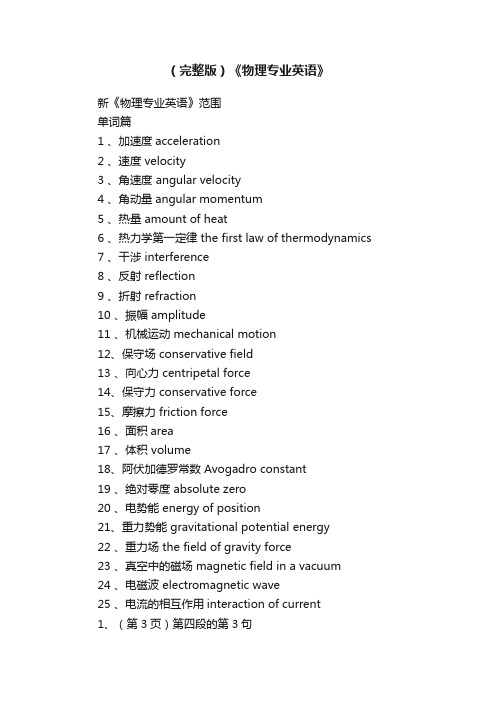
(完整版)《物理专业英语》新《物理专业英语》范围单词篇1 、加速度acceleration2 、速度 velocity3 、角速度 angular velocity4 、角动量angular momentum5 、热量 amount of heat6 、热力学第一定律 the first law of thermodynamics7 、干涉 interference8 、反射 reflection9 、折射 refraction10 、振幅 amplitude11 、机械运动 mechanical motion12、保守场 conservative field13 、向心力 centripetal force14、保守力 conservative force15、摩擦力 friction force16 、面积area17 、体积 volume18、阿伏加德罗常数 Avogadro constant19 、绝对零度 absolute zero20 、电势能 energy of position21、重力势能 gravitational potential energy22 、重力场 the field of gravity force23 、真空中的磁场 magnetic field in a vacuum24 、电磁波 electromagnetic wave25 、电流的相互作用interaction of current1、(第3页)第四段的第3句A typical problem of mechanics consists in determining the states of a system at all the following moments of time t when we know the state of the system at a certain initial moment to and also the law governing the motion.翻译:机械运动的一个典型的问题的构成取决于一个系统在接下来的时间间隔t的状态,(因此)当我们知道了一个确切的最初的系统状态时,也可以知道运动的规律。
物理学专业英语A4
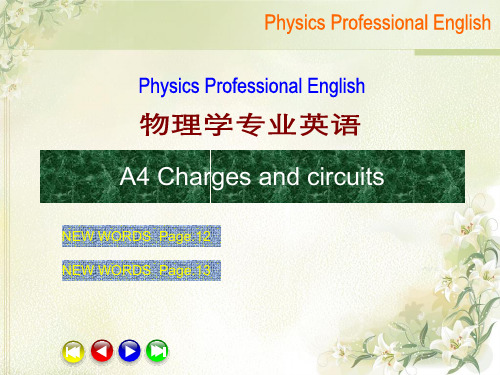
NEW WORDS Page.12 NEW WORDS Page.13
A4 Charges and circuits
• Static electricity • If two materials are rubbed together, electrons may be transferred from one to another. As a result, one gains negative charge, while the other is left with an equal positive charge. If the materials are insulators (see right), the transferred charge does not readily flow away. It is sometimes called static electricity.
A4 Charges and circuits
• Current • In the circuit above, chemical reactions in the cell push electrons out of the negative (-) terminal, round the circuit, to the positive (+) terminal. This flow of electrons is called a current.
A4 Charges and circuits
• Thermistors These components have a resistance which changes considerably with temperature (e.g. high when cold, low when hot). They contain semiconducting materials. • Light-dependent resistors (LDRs) These have a high resistance in the dark but a low resistance in the light. • Diodes These have an extremely high resistance in one direction but a low resistance in the other. In effect, they allow current to flow in oneCharges and circuits
- 1、下载文档前请自行甄别文档内容的完整性,平台不提供额外的编辑、内容补充、找答案等附加服务。
- 2、"仅部分预览"的文档,不可在线预览部分如存在完整性等问题,可反馈申请退款(可完整预览的文档不适用该条件!)。
- 3、如文档侵犯您的权益,请联系客服反馈,我们会尽快为您处理(人工客服工作时间:9:00-18:30)。
FRAME OF REFERENCE
The fact that if we choose different body as the reference to describe the same motion of a given object, the indications will be different, is called the relativity of the description and measurement of the motion, The particular body that serves as a reference chosen by the observer is defined as the frame of reference. It is usually pictured by means of a coordinate system, consisting three mutually perpendicular axes -X, -Y and Z-axes, and relative to it the position, velocity, acceleration and orbit of the moving object can be quantitatively specified. Particle is an ideal model used to simplify an object and to describe its motion. We can represent an object as a particle if every part of it moves in exactly the same way so that we can regard it as a mass point with no size and no shape. Translational motion -- the change of the position of the particle as a function of time will give a complete description of the motion for the given object.
Its three component equations are written by the following scalar functions
专业英语
English in physics
课程的性质和任务: 掌握与物理学基本内容相关的专业英语词汇、英文 书刊常用术语、增强学生阅读和翻译专业文献的能 力,具备基本的专业英语写作技能,为后续专业课 程及深造,奠定必要的学习基础 . 教材:1、physics in english 主编:李淑侠 出 版 社: 哈尔滨工业大学出版社 2、自编讲义
The Theory of Relativity
Part One Mechanics
Chapter Biblioteka Kinematics—Uniformly Accelerated Motion
Kinematics is the study of the geometry of motion: it deals with the mathematical description of motion in terms of position, velocity, and acceleration. Kinematics serves as a prelude to dynamics, which studies force as the cause of changes in motion.
r xi yj zk
POSITION VECTOR AND DISPLACEMENT: The position of a particle in space is a vector given by
in a rectangular coordinate system. The position vector as a function of time can determine the location of a particle at any given time. It is called position function and given by
Table of Contents
1 、 Introduction
2 、THE PHYSICAL FUNDAMENTALS OF MECHANICS 3、Thermodynamics 4 、Optics 5、 Electromagnetism 6、Modern Physics Quantum Physics and Wave Mechanics
